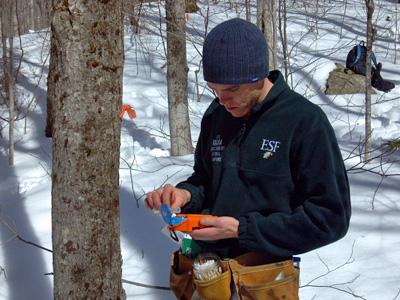Sugar Content of Maple Sap after N, P, or Ca Fertilization

Maple syrup is an important non-timber forest product in the northeastern United States and southeastern Canada. Sugar maples that are healthier often have higher sugar concentrations in their sap. Sap sweetness is economically important because it affects the amount of sap and the amount of fuel required to produce a gallon of syrup. The relationship between soil nutrients and sap sweetness is not well understood, although soil nitrogen and base cations, such as calcium, have been shown to be important to sugar maple health.
NSRC researchers investigated specific soil and foliar nutrients that might affect the sugar concentration of maple sap. Using a digital refractometer, they sampled 309 sugar maple trees for sap sweetness in five sites that had past nitrogen, phosphorus, and calcium additions in the White Mountains of New Hampshire. Trees with higher sugar concentrations in their sap were growing in sites with higher soil nitrogen mineralization, and trees with higher foliar nitrogen to phosphorus ratios had sweeter sap. Addition of nitrogen increased sap sweetness by 11% while nitrogen and phosphorus added together had no detectable effect on sap sweetness. Calcium was not related to sap sweetness. Researchers sampled sap sweetness of several sugar maple clones propagated by rooted cuttings in Heiberg Memorial Forest, Tully, New York. Unpublished data from the 1980s and data collected in 2014 showed sap sweetness differed by clone.
By selecting sites with higher soil nitrogen or fertilizing with nitrogen, maple syrup producers may be able to collect maple sap with higher sugar concentrations. Genetically sweeter sugar maples can be replicated through rooted cuttings.
